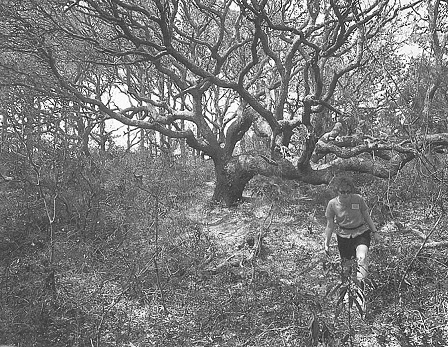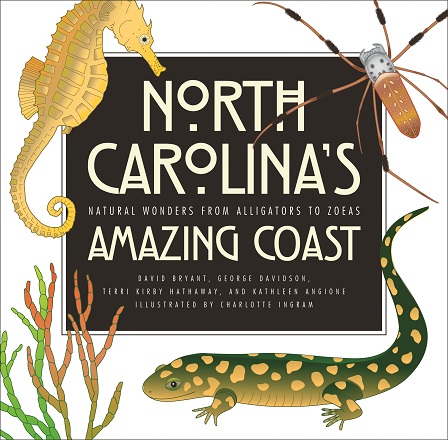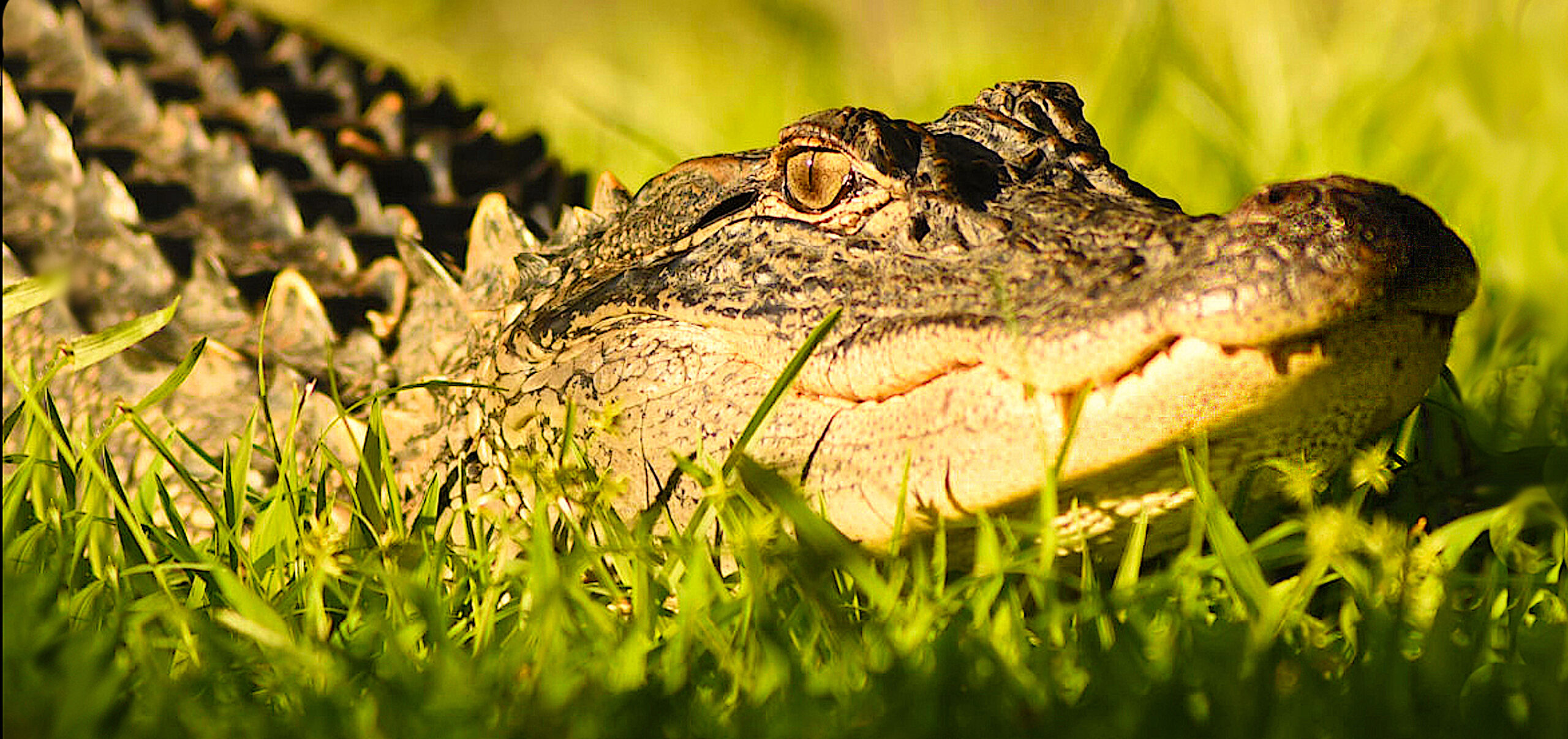AMAZING COAST: Hear the Call of a Maritime Forest

Nichole Riddle is a communications intern with North Carolina Sea Grant. She is a senior at North Carolina State University.
Summer is finally here. If you need a break from the glaring sun and crowded beaches, why not visit a Maritime Forest? They’re located conveniently close to popular summer hot spots.

North Carolina’s maritime forests are a unique and increasingly rare feature of our coast. A variety of hardy trees make up each forest. They are able to withstand the strong winds, salt spray and even the short-term submersion under salt water often associated with life near the ocean.
These and other traits of the individual trees provide services that enable the forest as a whole to survive.
When the forest thrives, the surrounding ecosystems do as well. Strong root systems help prevent much of the soil around them from washing away during storms. Those same roots also help to purify and contain groundwater.
The tree canopies slow down winds that could damage smaller trees or manmade structures, as well as provide a resting place for migrating and breeding bird populations. Larger, more robust trees, such as the loblolly pine and the American holly, can shield smaller trees, like dogwoods, and create a more exciting and diverse environment.
While they can be found in coastal areas of the mainland, maritime forests primarily form in the sandy soils on the backs of barrier islands, where they help to stabilize shifting sands.
A strong chain of barrier islands in turn helps to protect the rest of the state. The islands themselves minimize damage to the mainland, providing protection from strong storm surges and high winds. Their presence also helps create and maintain a unique ecosystem.
One of the most distinctive features of many maritime forests is the live oak, Quercus virginiana.
While relatively fast-growing, many live oaks are very old. There is one in Hampstead, off U.S. 17, that, according to local legend, shaded George Washington when he stopped and ate lunch during a 1791 tour of the southern states.
The wood of live oak trees even was used in shipbuilding for a time. Ever heard of Old Ironsides? The USS Constitution is the oldest commissioned vessel in the U.S. Navy, and one of the oldest in the world.
Wood from live oaks was used in several areas during construction of the ship, including the ribs of her triple-layered hull. While she’s had many repairs through the years, some estimates suggest that between 10 and 15 percent of the original wood is still part of the ship. Not bad for a frigate launched in October 1797.
You can’t see a live oak and not notice the Spanish moss, Tillandsia usneoides, hanging down from the branches. While it may grow in the trees, this epiphyte gets all its essential nutrients from the air around it, causing no harm to its gracious hosts in the process. Although the name suggest otherwise, Spanish moss is native to the southeastern United States, and has been used for various purposes through the years.
Even though it’s related to the pineapple, it is not very useful as food. The moss has been brewed into teas to treat a variety of ailments, from fevers to childbirth pains. It has been woven into blankets and mats, used as mulch, and even has been used to stuff car seats and mattresses. While not commonly used for mattresses anymore, there is one forest inhabitant that still regularly uses it for bedding.
Peer closely into the moss and you may see a nesting painted bunting. Mature males are the most distinctive, displaying bright blues, greens and oranges in their feathers. Young males and females are a more demure green.
Even with the vibrant colors, painted buntings still can be easy to overlook. They’re smaller than the eastern bluebird. Listen for their short chirps or the high-pitched songs of males.
While not a year-round resident of North Carolina, you still can see Passerina ciris during spring and summer as they fly up from the Caribbean and Florida to nest and breed along our coast.
This member of the cardinal family has found itself listed “Near Threatened” under the federal Endangered Species Act. Destruction of necessary habitat and capture for sale as pets have contributed to a decline in wild populations.
Sometimes called a rainfrog, the green tree frog has several distinctive calls — one of which heralds rain.
You even may have seen one of these little guys clinging to the side of your house. It’s a clever strategy they use to easily catch their favorite insects that are attracted to lights.
When not in suburbia, Hyla cinera can be found in very moist areas. Swamps, marshes, lakes and streams all are ideal environments — and the trees of maritime forests, of course. You may have a hard time seeing one in action, though, because they’re nocturnal. During the day, they hide in shady spots, such as the underside of leaves.
Even though they are legless, the eastern glass lizards, or Ophisaurus ventralis, are not snakes. External ear openings and eyelids are two characteristics that differentiate them from snakes. They also cannot unhinge their jaws while eating. This limits food sources to what can fit between their jaws, with grasshoppers topping the menu.
The color of a glass lizard can vary greatly. Browns, yellow and greens all are potential options.
The species has developed an effective survival mechanism over time — the ability to break off its tail when attacked. This breakage gives the lizard a chance to escape. It’s even a repeatable trick. The tail eventually will grow back!
With water-repellent fur, ears and nostrils that can close while diving, and strong lungs capable of holding breath for up to eight minutes, the river otter was made for life in the water. However, the Lontra canadensis is not related at all to the sea otter. It actually is part of the weasel family.
While fishes are their preferred food, river otters are opportunistic eaters. They won’t turn up their noses if dinner happens to be turtle, crayfish or bird.
Water pollution and the fur trade decimated river otter populations across the U.S. in the late 1800s and early 1900s. Thanks to conservation efforts, they have bounced back. Look carefully next time you’re near a river and you may see some playing in the water or sunning on the bank.
Information from this article was gathered from North Carolina’s Amazing Coast: Natural Wonders from Alligators to Zoeas by David Bryant, George Davidson, Terri Kirby Hathaway and Kathleen Angione. The book is a partnership among North Carolina and Georgia Sea Grant programs and UGA Press.
EXPLORE
No two maritime forests are the same. While there are some classifications, such as deciduous or swamp forests, there still can be major differences based on factors such as age or location.
Visit some of North Carolina’s maritime forests.
- Theodore Roosevelt State Natural Area, near the N.C. Aquarium at Pine Knoll Shores on Bogue Banks Island. Details at www.ncaquariums.com/pine-knoll-shores, search Theodore Roosevelt.
- Buxton Woods Reserve, on Hatteras Island, and other sites in the N.C. Coastal Reserve and National Estuarine Research Reserve. Details at www.nccoastalreserve.net.
- Nags Head Woods Ecological Preserve, in Dare County. Details at www.nature.org/northcarolina, search Nags Head.
All of these forests and several others are near points of historical and cultural significance, so drop by when you’re in the area.
GET INVOLVED
Some of the species mentioned in this piece are nearly threatened or have recently recovered. Maritime forests themselves are on the decline, through natural and man-made processes.
Many state parks and N.C. Coastal Reserve sites have volunteer opportunities available for those interested.
Citizen science projects often don’t take up much time individually, but collectively can compile volumes of important data.
The Painted Bunting Observer Team, or PBOT, is one such example. Volunteers help by noting sightings of painted buntings in the Carolinas and Florida. The data are used to help track the stability of the eastern population of the species.
For more information, visit www.paintedbuntings.org.
This article was published in the Summer 2015 issue of Coastwatch.
For contact information and reprint requests, visit ncseagrant.ncsu.edu/coastwatch/contact/.
- Categories:


